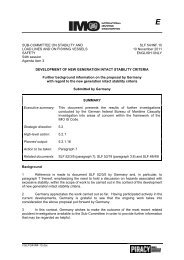Examination of the intact stability and the seakeeping behaviour
Examination of the intact stability and the seakeeping behaviour
Examination of the intact stability and the seakeeping behaviour
Create successful ePaper yourself
Turn your PDF publications into a flip-book with our unique Google optimized e-Paper software.
5 Evaluation<br />
Transverse acceleration on <strong>the</strong> bridge in<br />
ballast arrival loading condition [m/s 2 ]<br />
16<br />
14<br />
12<br />
10<br />
8<br />
6<br />
4<br />
2<br />
0<br />
9<br />
2468 TEU in<br />
accident<br />
10<br />
8<br />
4<br />
13 12<br />
5<br />
7<br />
6<br />
CE in accident<br />
2<br />
3<br />
1<br />
15<br />
14 = CE<br />
4 6 8 10 12 14<br />
GM solid [m]<br />
11<br />
Accident situation 1 Accident situation 2 Accident situation 3<br />
Figure 5.1: Transversal accelerations on <strong>the</strong> bridge against GM solid<br />
5.2 Consequences<br />
Normally it is expected that large vessels with a length <strong>of</strong> over 200 m or even 300 m are relatively<br />
safe in heavy sea <strong>and</strong> do not experience an exceptional <strong>seakeeping</strong> behavior. But <strong>the</strong> analysis<br />
reveals, that most <strong>of</strong> <strong>the</strong> considered container vessels apparently have signicant problems with<br />
<strong>the</strong>ir <strong>seakeeping</strong> behavior in combinations <strong>of</strong> certain loading <strong>and</strong> environmental conditions.<br />
In exception to <strong>the</strong> above stated <strong>the</strong> three largest vessels, namely Vessel No. 11, Vessel<br />
No. 14 <strong>and</strong> Vessel No. 15, experience smaller rolling angles <strong>and</strong> accelerations during <strong>the</strong> examination<br />
(see gure 5.1). Simply looking at this result, it could be concluded, that <strong>the</strong>se large<br />
vessels generally do not have problems in <strong>the</strong> considered seaways. But with Vessel No. 14,<br />
<strong>the</strong> Chicago Express takes part <strong>of</strong> <strong>the</strong> examination, being <strong>the</strong> vessel in accident, which is described<br />
with accident situation 1 (refer to table 3.1). During this accident very high rolling angles<br />
<strong>and</strong> transversal accelerations on <strong>the</strong> bridge occurred in a dierent loading condition (compare<br />
BSU report [1]).<br />
The examined ballast arrival condition diers from <strong>the</strong> accident loading condition. The<br />
Chicago Express now has a smaller displacement <strong>and</strong> GM as well as a dierent trim. This<br />
implies that <strong>the</strong> o<strong>the</strong>r large vessels, Vessel No. 11 <strong>and</strong> Vessel No. 15 may also be endangered<br />
to experience equally high high transversal accelerations in a dierent loading condition. This<br />
assumption is analysed fur<strong>the</strong>r in chapter 6.2.<br />
The problems in <strong>the</strong> <strong>seakeeping</strong> behavior occur due to <strong>the</strong> following reasons: The shaped hull<br />
form <strong>and</strong> <strong>the</strong> signicant bow are <strong>of</strong> <strong>the</strong> analysed vessels favours <strong>the</strong> impact <strong>of</strong> direct, exciting<br />
heeling moments through <strong>the</strong> heavy sea. On <strong>the</strong> o<strong>the</strong>r h<strong>and</strong>, <strong>the</strong> excessive <strong>stability</strong> causes high<br />
restoring moments <strong>of</strong> <strong>the</strong> heeled vessel. This results in signicant transversal accelerations (see<br />
[8] for more details).<br />
Fur<strong>the</strong>rmore <strong>the</strong> examination shows that <strong>the</strong> problem <strong>of</strong> excessive rolling angles <strong>and</strong> transversal<br />
44

















